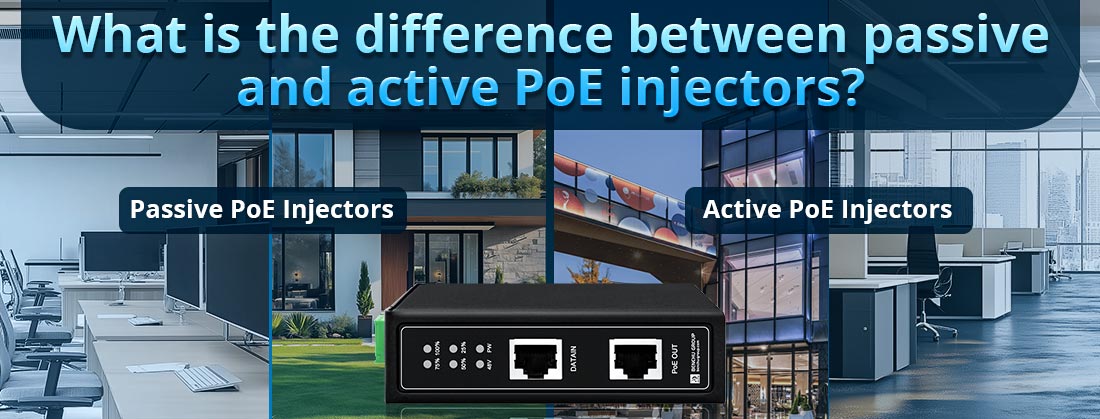
Différence entre les injecteurs PoE passifs et actifs
Les injecteurs PoE passifs et les injecteurs PoE actifs sont tous deux utilisés pour fournir de l'énergie et des données aux périphériques réseau via un seul câble Ethernet. Cependant, ils fonctionnent différemment en termes de puissance délivrée, de compatibilité des appareils et de fonctionnalités. Voici une comparaison détaillée :
1. Injecteurs PoE passifs
Passif Injecteurs PoE fournir de l'énergie à une tension fixe sans aucune négociation de puissance ni communication avec l'appareil alimenté (PD).
Caractéristiques clés :
--- Pas de négociation : les injecteurs PoE passifs ne communiquent pas avec l'appareil connecté pour déterminer ses besoins en énergie. Ils fournissent de l’énergie en fonction d’une tension et d’un courant prédéfinis.
--- Sortie de tension fixe : la tension est souvent prédéfinie par le fabricant (par exemple, 12 V, 24 V ou 48 V). L'injecteur ajoute simplement cette tension au câble Ethernet.
--- Non standardisé : les injecteurs PoE passifs ne respectent pas les normes IEEE PoE (par exemple, 802.3af/at/bt).
--- Coût inférieur : les injecteurs passifs sont généralement moins chers en raison de leur conception plus simple et du manque de fonctionnalités de négociation de puissance.
--- Compatibilité des appareils : les injecteurs PoE passifs sont généralement utilisés avec des appareils propriétaires spécialement conçus pour fonctionner avec la tension fixe fournie (par exemple, les équipements Ubiquiti, Mikrotik).
Cas d'utilisation :
--- Pour les réseaux petits ou propriétaires où tous les appareils sont compatibles avec la tension fixe de l'injecteur.
--- Pour les appareils existants ou spécialisés qui ne prennent pas en charge les normes PoE actives.
Risques :
--- Dommages potentiels : la connexion d'un injecteur PoE passif à un appareil qui n'est pas conçu pour gérer la tension fournie peut endommager l'appareil.
--- Flexibilité limitée : les injecteurs passifs ne peuvent pas ajuster automatiquement la puissance de sortie pour répondre aux différentes exigences de l'appareil.
2. Injecteurs PoE actifs
Les injecteurs PoE actifs sont conformes aux normes IEEE PoE et incluent des capacités de négociation de puissance pour garantir la compatibilité et un fonctionnement sûr avec l'appareil alimenté.
Caractéristiques clés :
--- Négociation d'alimentation : les injecteurs actifs communiquent avec l'appareil connecté via un processus de prise de contact (par exemple, LLDP ou protocoles de détection) pour déterminer les besoins en énergie de l'appareil avant de fournir de l'énergie.
Basé sur des normes : les injecteurs PoE actifs respectent les normes IEEE, telles que :
--- 802.3af (PoE) : jusqu'à 15,4 W
--- 802.3at (PoE+) : jusqu'à 30 W
--- 802.3bt (PoE++) : Jusqu'à 60-100W
Réglage dynamique de la tension : l'injecteur ajuste la tension et la puissance de sortie en fonction des exigences de l'appareil.
Compatibilité universelle : compatible avec tout appareil conforme à la norme IEEE, garantissant l'interopérabilité entre différentes marques et appareils.
Cas d'utilisation :
--- Pour alimenter des appareils modernes tels que des caméras IP, des points d'accès sans fil, des téléphones VoIP et d'autres équipements réseau conformes à la norme IEEE.
--- Pour les réseaux dynamiques à grande échelle dans lesquels des appareils de plusieurs fabricants sont utilisés.
Avantages:
--- Sécurité : les injecteurs actifs garantissent que l'alimentation est fournie uniquement si l'appareil connecté est compatible et nécessite de l'énergie, réduisant ainsi le risque de dommages causés par une surtension.
--- Flexibilité : ils peuvent s'adapter aux besoins de différents appareils, ce qui les rend plus polyvalents dans les environnements multi-appareils.
--- Pérennité : la prise en charge des normes IEEE évolutives garantit la compatibilité avec les nouveaux appareils.
Tableau de comparaison : injecteurs PoE passifs et actifs
| Fonctionnalité | Injecteur PoE passif | Injecteur PoE actif |
| Négociation de pouvoir | Aucun (Tension fixe, toujours allumé) | Négocie l'alimentation avec l'appareil |
| Normes IEEE | Non conforme | Conforme IEEE (802.3af/at/bt) |
| Sortie de tension | Fixe (par exemple, 12 V, 24 V, 48 V) | Dynamique (par exemple, 44-57 V basé sur la norme) |
| Compatibilité des appareils | Appareils propriétaires ou à tension fixe uniquement | Tout appareil compatible IEEE |
| Sécurité | Risque de dommages dus à une surtension | Sûr grâce à la négociation de pouvoir |
| Coût | Inférieur | Plus haut |
| Applications | Réseaux propriétaires, appareils existants | Réseaux standardisés, configurations multimarques |
Considérations clés lors du choix entre des injecteurs PoE passifs et actifs
Compatibilité des appareils :
--- Utilisez des injecteurs PoE passifs uniquement si tous vos appareils sont explicitement conçus pour gérer leur sortie de tension fixe.
--- Utilisez des injecteurs PoE actifs pour les appareils modernes conformes à la norme IEEE ou si vous n'êtes pas sûr des besoins en énergie des appareils.
Sécurité:
--- Les injecteurs actifs sont plus sûrs car ils empêchent la fourniture d'énergie aux appareils non conformes.
Échelle du réseau :
--- Pour les configurations propriétaires ou à petite échelle avec des exigences fixes, des injecteurs passifs peuvent suffire.
--- Pour les réseaux dynamiques plus vastes comportant divers appareils, les injecteurs actifs sont plus fiables et évolutifs.
Coût:
--- Les injecteurs passifs sont plus économiques mais comportent des limites.
--- Les injecteurs actifs constituent un meilleur investissement à long terme pour les réseaux évolutifs et standardisés.
Conclusion
Les injecteurs PoE passifs sont rentables et adaptés aux appareils spécialisés ou propriétaires, mais manquent de flexibilité et de fonctionnalités de sécurité.
Les injecteurs PoE actifs sont le choix préféré des réseaux modernes en raison de leur conformité aux normes IEEE, de leur négociation dynamique de puissance et de leur compatibilité universelle, garantissant une alimentation électrique sûre et efficace.